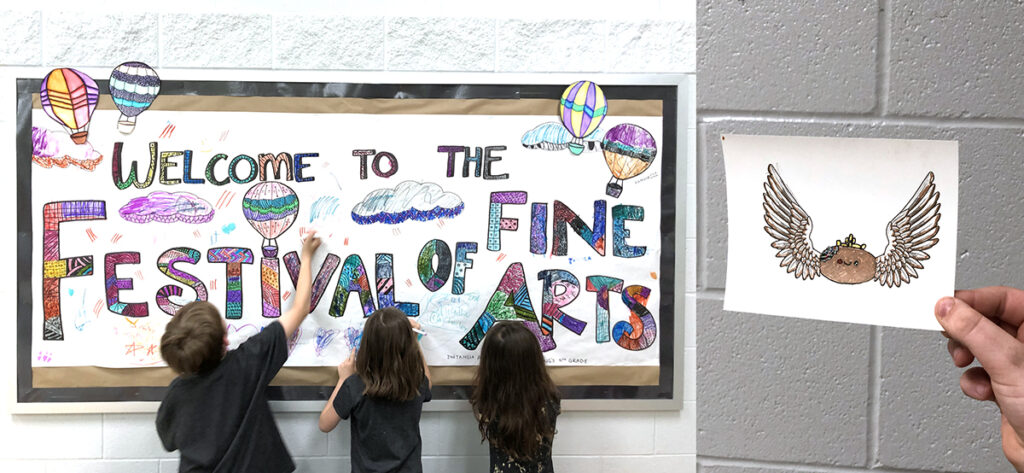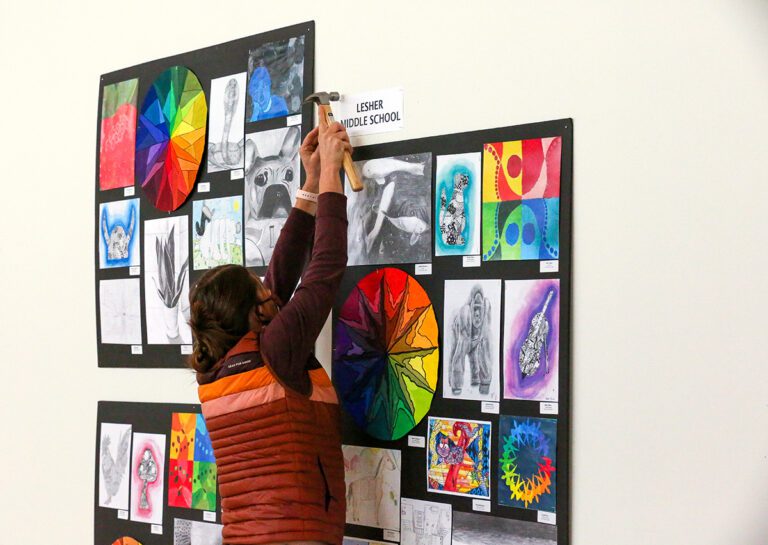A big part of our job as art teachers is to put on a huge art show each year, usually in the spring, to showcase the work and talent from the year. Over the past two years, art teachers have pivoted to online platforms, outdoor exhibitions, or regrettably canceled their beloved community events. Now is an opportunity to re-evaluate the purpose of your art show. Take a step back to consider your show’s impact on your community and your community’s impact on your show. As you consider what your art show might be (this year and into the future) and how to engage your community, keep these three tips in mind: don’t over-commit, keep it reasonable, and ask for help.
Let’s take a closer look at six components that make a strong art show and foster community connections.

1. Finding Volunteers
Community partnerships start with volunteers. Some art teachers are blessed with a few strong volunteers that stick with a program over time. They can work on a flexible schedule to help wrap clay projects, mat artworks, or cut paper. These individuals can also hang artwork or cut and prep supplies in advance for hands-on activity stations at your art show. (Keep reading to learn more about these activity stations.)

What if you don’t have a solid group of parent volunteers? Well, me neither, but we can start now. Make a list of all the tasks a volunteer could assist you with, check your school’s protocols for parent helpers, and ask for specific help with specific tasks. These tasks (including matting or labeling artwork) can be done at a volunteer’s home if you are comfortable sending home supplies. Additionally, don’t forget about your school PTO/PTA. They may have a list of potential helpers who are already invested in supporting the school’s culture.
If you need assistance hanging artwork, consider these simple steps:
- Sort and organize all the artwork to be hung. For maximum efficiency, get this into your routine at the beginning of the year. As students finish up each project, immediately sort and organize the work and store it in a safe place.
- Type up a quick explanation for hanging artwork that you can use at any time and with any volunteer. Be sure to include lining work up with the cement block grooves or using one staple in the corner of the mat or mounting paper to prevent tiny holes in the artwork. Outline details that only an art teacher would think about.
- Mark off the wall or assign a bulletin board where the art is to be displayed.
- Gather all hanging supplies, including hooks, staples, staplers, packing tape, clips, or whatever system you have in place. Store these supplies in one location, such as a tackle box, to be given to volunteers when they drop in to help.
- Thank volunteers enthusiastically for their support.
Tip: Don’t over-commit, keep it reasonable, and ask for help.
The school community also includes the teachers and staff in the building. Schedule an art hanging party right after school, and have all of the planning mentioned above ready to go for staff volunteers. The process may prompt the other teachers’ awareness of the work you have done on your own for years. Seeing their students’ artwork will also bring a huge smile to their faces, which is a great way to end any stressful day.
2. Procuring Donations
Scavenger hunts are a meaningful way to get all art show attendees to look at all of the displayed work and not just their own. When students complete a scavenger hunt form and turn it in, hand them an amazing prize in return! The following day, pull out one of the forms and announce the winner to the school community. This prize does not need to come from your own bank account but can be the result of donations from local businesses. A prize basket comprised of local contributions would make any scavenger hunter enthused. Or split up the donations to reward several students. For a few years, a local chocolatier donated a chocolate bar for every participant who completed the scavenger hunt at my school art show. This is excellent publicity for them and their generosity. It is also a definite win for many attendees.

Tip: Don’t over-commit, keep it reasonable, and ask for help.
Have you ever offered snacks or cookies for attendees? Try reaching out to a local grocer or bakery for treats that don’t pull from your budget or paycheck. A local food truck or two can park in front of the school, offering a quick bite for attendees. Inquire about a fundraiser with the food truck owner for a potential cut of the profits for your art program.

3. Prepping Hands-On Activity Stations
As previously mentioned, volunteers can help prep for any hands-on artmaking experiences you want to provide for art show attendees. Try basing the stations on a broad theme to tie potentially disparate activities together or motivate you to develop ideas in advance. For her first-ever school-based art show, elementary art teacher Amy Harmon developed activity stations based on the theme Flight. A hot air balloon mural was available for students to color. A volunteer cut up paper bookmarks with a set of wings copied on each strip. Attendees would draw items between the pair of wings to make creations such as watermelons with wings, cats with wings, or winged robots.

Tip: Don’t over-commit, keep it reasonable, and ask for help.
Consider if you want or even need to offer these experiences. If you still would like to, limiting the number of activities can help keep things manageable. And if the past few years have taught you that these activities are not a priority for you or that you do not have the capacity right now—it is okay. It can always wait for another year.

4. Featuring Special Guests
Team up with a local art supply company to see if they will participate in your event. It is good for families to know where to go locally for art supplies, and having their presence at the school art show is an excellent place to start. The shop may set up a display or offer prizes for participants or award winners. Inquire if they would be willing to run a hands-on activity station themselves. This is a great way to take the prep, planning, and supplies off your shoulders and engage the community itself.

To make the art show an event to remember, invite community organizations to get involved in a meaningful way. Musical acts, groups, or solos can complement the artistic experience. Does a local art center or museum offer summer camps your students would enjoy? Invite a representative to the art show to broaden the center’s clientele and act as a resource for parents.
A local zoo or nature center can bring an animal ambassador to your event to discuss conservation efforts. This can be especially poignant if the animal visitor is featured in the artwork on view. A few years ago, a box turtle artist had his own “Meet the Artist” booth at my school art show. He had previously worked with first graders on an interactive artmaking activity while they learned about backyard conservation.

5. Planning Publicity
Prioritize meaningful publicity for successful community invites. Posters, postcards, banners, or even bracelets are all ideas that can invite the broader community to enjoy the efforts of your art curriculum. Invite local business owners, politicians, school district leaders, university students, and artists to your event. Think about the benefits of engaging each of these individuals with your students’ work. For details and further ideas on publicizing your art show, check out the article 10 Ways to Market Your Art Show.
Tip: Don’t over-commit, keep it reasonable, and ask for help.
Donations do not have to be physical, but they can also include space. Who has space to hang posters or banners advertising your art show within the community? A local store can hang an art show poster in their window. A bulletin board at the local coffee shop can remind families to save the date. Give a parent volunteer who can’t help during the school day a stack of posters to hang locally on their own time. You do not know what is possible until you ask.
6. Keep the Fun Going
Many local establishments have space to hang student artwork. After the school-based art show is over, inquire about display opportunities to share student work out in the community. Coffee shops, barbershops, dentist offices, acupuncture studios, local libraries, and the school district administrative offices may welcome student artwork. They may even offer a small reception to recognize student artists and their families. You already have artwork gallery-ready, so why not share it with as broad an audience as possible?

A successful art show does not need to rest on your singular shoulders. “Success” means you are not stretched to your limit and that others feel invested in the school community. Potential volunteers are waiting—they simply need a little direction to help execute your dreams for a fun and engaging art show. Don’t over-commit, keep it reasonable, and ask for help.
Who in your school community would make an excellent art show volunteer? Make a list, then reach out to ask for help.
What are your art show goals this year? What can wait until next year?
Which community businesses, organizations, and leaders will you ask to partner with for an exciting art show event this spring?
Magazine articles and podcasts are opinions of professional education contributors and do not necessarily represent the position of the Art of Education University (AOEU) or its academic offerings. Contributors use terms in the way they are most often talked about in the scope of their educational experiences.





